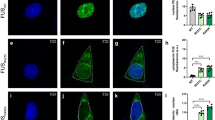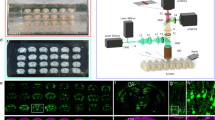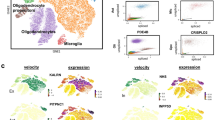Abstract
Brain diseases such as autism and Alzheimer's disease (each inflicting >1% of the world population) involve a large network of genes displaying subtle changes in their expression1. Abnormalities in intraneuronal transport have been linked to genetic risk factors found in patients2,3, suggesting the relevance of measuring this key biological process. However, current techniques are not sensitive enough to detect minor abnormalities. Here we report a sensitive method to measure the changes in intraneuronal transport induced by brain-disease-related genetic risk factors using fluorescent nanodiamonds (FNDs). We show that the high brightness, photostability and absence of cytotoxicity4 allow FNDs to be tracked inside the branches of dissociated neurons with a spatial resolution of 12 nm and a temporal resolution of 50 ms. As proof of principle, we applied the FND tracking assay on two transgenic mouse lines that mimic the slight changes in protein concentration (∼30%) found in the brains of patients. In both cases, we show that the FND assay is sufficiently sensitive to detect these changes.
This is a preview of subscription content, access via your institution
Access options
Subscribe to this journal
Receive 12 print issues and online access
$259.00 per year
only $21.58 per issue
Buy this article
- Purchase on Springer Link
- Instant access to full article PDF
Prices may be subject to local taxes which are calculated during checkout





Similar content being viewed by others
References
McClellan, J. & King, M.-C. C. Genetic heterogeneity in human disease. Cell 141, 210–217 (2010).
Hirokawa, N., Niwa, S. & Tanaka, Y. Molecular motors in neurons: transport mechanisms and roles in brain function, development, and disease. Neuron 68, 610–638 (2010).
Millecamps, S. & Julien, J.-P. Axonal transport deficits and neurodegenerative diseases. Nat. Rev. Neurosci. 14, 161–176 (2013).
Schirhagl, R., Chang, K., Loretz, M. & Degen, C. L. Nitrogen-vacancy centers in diamond nanoscale: sensors for physics and biology. Annu. Rev. Phys. Chem. 65, 83–105 (2014).
de Angelis, M. H. et al. Analysis of mammalian gene function through broad-based phenotypic screens across a consortium of mouse clinics. Nat. Genet. 47, 969–978 (2015).
Kwinter, D. M., Lo, K., Mafi, P. & Silverman, M. A. Dynactin regulates bidirectional transport of dense-core vesicles in the axon and dendrites of cultured hippocampal neurons. Neuroscience 162, 1001–1010 (2009).
Pinaud, F., Clarke, S., Sittner, A. & Dahan, M. Probing cellular events, one quantum dot at a time. Nat. Methods 7, 275–285 (2010).
Mudrakola, H. V., Zhang, K. & Cui, B. Optically resolving individual microtubules in live axons. Structure 17, 1433–1441 (2009).
Chang, Y.-R. et al. Mass production and dynamic imaging of fluorescent nanodiamonds. Nat. Nanotech. 3, 284–288 (2008).
Wu, T. et al. Tracking the engraftment and regenerative capabilities of transplanted lung stem cells using fluorescent nanodiamonds. Nat. Nanotech. 8, 682–689 (2013).
Huang, Y.-A. et al. The effect of fluorescent nanodiamonds on neuronal survival and morphogenesis. Sci. Rep. 4, 6919 (2014).
Blanpied, T., Scott, D. & Ehlers, M. Dynamics and regulation of clathrin coats at specialized endocytic zones of dendrites and spines. Neuron 36, 435–449 (2002).
Overly, C. C., Rieff, H. I. & Hollenbeck, P. J. Organelle motility and metabolism in axons vs dendrites of cultured hippocampal neurons. J. Cell Sci. 109, 971–980 (1996).
Rodriguez-Boulan, E., Kreitzer, G. & Müsch, A. Organization of vesicular trafficking in epithelia. Nat. Rev. Mol. Cell Biol. 6, 233–247 (2005).
Chen, J., Kanai, Y., Cowan, N. J. & Hirokawa, N. Projection domains of MAP2 and tau determine spacings between microtubules in dendrites and axons. Nature 360, 674–676 (1992).
Courty, S., Luccardini, C., Bellaiche, Y., Cappello, G. & Dahan, M. Tracking individual kinesin motors in living cells using single quantum-dot imaging. Nano Lett. 6, 1491–1495 (2006).
Stokin, G. B. et al. Axonopathy and transport deficits early in the pathogenesis of Alzheimer's disease. Science 307, 1282–1288 (2005).
Encalada, S. E. & Goldstein, L. S. B. Biophysical challenges to axonal transport motor-cargo deficiencies and neurodegeneration. Annu. Rev. Biophys. 43, 141–169 (2014).
Querfurth, H. W. & LaFerla, F. M. Alzheimer's disease. N. Engl. J. Med. 362, 329–344 (2010).
Vossel, K. A. et al. Tau reduction prevents Aβ-induced defects in axonal transport. Science 330, 198 (2010).
Maussion, G. et al. Convergent evidence identifying MAP/microtubule affinity-regulating kinase 1 (MARK1) as a susceptibility gene for autism. Hum. Mol. Genet. 17, 2541–2551 (2008).
Lepagnol-Bestel, A. M. et al. SLC25A12 expression is associated with neurite outgrowth and is upregulated in the prefrontal cortex of autistic subjects. Mol. Psychiatry 13, 385–397 (2008).
Lakadamyali, M. Navigating the cell how motors overcome roadblocks and traffic jams to efficiently transport cargo. Phys. Chem. Chem. Phys. 16, 5907–5916 (2014).
Mandelkow, E.-M., Thies, E., Trinczek, B., Biernat, J. & Mandelkow, E. MARK/PAR1 kinase is a regulator of microtubule-dependent transport in axons. J. Cell Biol. 167, 99–110 (2004).
Fromer, M. et al. De novo mutations in schizophrenia implicate synaptic networks. Nature 506, 179–184 (2014).
Palmieri, L. et al. Altered calcium homeostasis in autism-spectrum disorders: evidence from biochemical and genetic studies of the mitochondrial aspartate/glutamate carrier AGC1. Mol. Psychiatry 15, 38–52 (2010).
Nakamura, H. et al. Quantitative analysis of intraneuronal transport in human iPS neurons. J. Pharmacol. Sci. 128, 170–178 (2015).
Mayer, L. et al. Single KTP nanocrystals as second-harmonic generation biolabels in cortical neurons. Nanoscale 5, 8466–8471 (2013).
Doudna, J. A. & Charpentier, E. The new frontier of genome engineering with CRISPR-Cas9. Science 346, 1258096 (2014).
Choi, S. H. et al. A three-dimensional human neural cell culture model of Alzheimer's disease. Nature 515, 274–278 (2014).
Paşca, A. M. et al. Functional cortical neurons and astrocytes from human pluripotent stem cells in 3D culture. Nat. Methods 12, 671–678 (2015).
Su, L.-J. et al. Creation of high density ensembles of nitrogen–vacancy centers in nitrogen-rich type Ib nanodiamonds. Nanotechnology 24, 315702 (2013).
Chenouard, N., Bloch, I. & Olivo-Marin, J. C. Multiple hypothesis tracking for cluttered biological image sequences. IEEE Trans. Pattern Anal. Mach. Intell. 35, 2736–2750 (2013).
Klein, W. L. Aβ toxicity in Alzheimer's disease globular oligomers (ADDLs) as new vaccine and drug targets. Neurochem. Int. 41, 345–352 (2002).
Acknowledgements
We thank P. Tchénio for his comments on the manuscript, A. Lombard for his contribution to data processing and J. Lipecka for her help with western blotting. This work was supported by a public grant overseen by the French National research Agency (ANR) as part of the Investissement d'Avenir programme IDEX Paris-Saclay ANR-11-IDEX- 0003-02 (S.H.); the ANR and the Ministry of Science and Technology (Taiwan) through grant ANR-2010-INTB-1002 (M.S., F.T., H.-C.C. and C.-C.W.); the ANR through the Eranet Euronanomed project 2011-ERNA-006 (F.T., M.S., C.S. and A.C.); the Fondation Jérôme Lejeune (M.S.), the European Union FP7-Health (Grant Agreement n° 305299) AgedBrainSysBio grant (M.S.); grant number 12018592 from Region Ile-de-France (F.T.); CNRS Programme Interdisciplinaire (F.T. and M.S.) and Triangle de la Physique contract no. 2012-038T (F.T. and M.S.).
Author information
Authors and Affiliations
Contributions
S.H., F.T. and M.S. conceived and designed the experiments. S.H., N.M., Y.L.-M., A.-M.L.-B., M.-P.A., S.M., X.L.L., J.V., C.P., E.D., C.R. and R.D. performed the experiments. S.H., N.M., S.M., M.-P.A. and X.L.L. analysed the data. P.K., F.-J.H., C.-C.W., B.P., Y.H., C.S., A.C., B.A. and H.-C.C. contributed to materials and analysis tools. S.H., F.T. and M.S. wrote the paper.
Corresponding authors
Ethics declarations
Competing interests
The authors declare no competing financial interests.
Supplementary information
Supplementary information
Supplementary information (PDF 3652 kb)
Supplementary information
Supplementary Movie 1 (MP4 1290 kb)
Supplementary information
Supplementary Movie 2 (MP4 5162 kb)
Supplementary information
Supplementary Movie 3 (MP4 2743 kb)
Supplementary information
Supplementary Movie 4 (MP4 2158 kb)
Supplementary information
Supplementary Movie 5 (MP4 11839 kb)
Supplementary information
Supplementary Movie 6 (MP4 915 kb)
Rights and permissions
About this article
Cite this article
Haziza, S., Mohan, N., Loe-Mie, Y. et al. Fluorescent nanodiamond tracking reveals intraneuronal transport abnormalities induced by brain-disease-related genetic risk factors. Nature Nanotech 12, 322–328 (2017). https://doi.org/10.1038/nnano.2016.260
Received:
Accepted:
Published:
Issue Date:
DOI: https://doi.org/10.1038/nnano.2016.260
This article is cited by
-
Toxicity and biodistribution of nanodiamond coupled with calcein
Journal of Materials Science (2023)
-
Applications of nanodiamonds in the diagnosis and treatment of neurological diseases
Journal of Nanoparticle Research (2022)
-
Quantifying nanodiamonds biodistribution in whole cells with correlative iono-nanoscopy
Nature Communications (2021)
-
Wide-field fluorescent nanodiamond spin measurements toward real-time large-area intracellular thermometry
Scientific Reports (2021)
-
Time for NanoNeuro
Nature Methods (2021)



